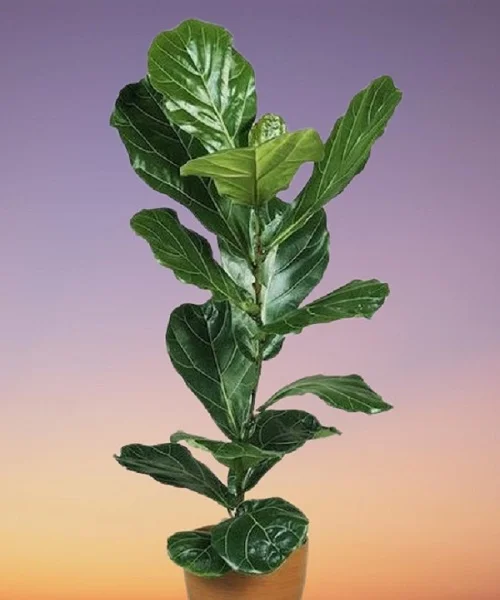How to Propagate Fiddle Leaf Fig | 3 Methods of Ficus lyrata Propagation
Some links in this post may be affiliate links
Fiddle Leaf Fig (Ficus lyrata) is best propagated at the beginning of the growing season by air layering or from stem tip cuttings which can be rooted either in soil or in water.
Ficus lyrata is one of the large-leafed bold statement plants as it bears striking large, violin-like leathery leaves with prominent veins and a wavy margin.
According to Petal Republic, Fiddle Leaf Fig is toxic to both humans and pets if ingested. It produces a sap that may cause skin irritation on sensitive skin. Always wear gloves when handling this plant.
Fiddle Leaf Fig flourishes in bright light with some direct sunlight, warm and humid conditions and moderately moist, fertile, well-drained soil coupled with monthly feeding during the growing season. Read more on how to grow and care for Fiddle Leaf Fig.
Fiddle Leaf Fig is easily propagated from stem tip cuttings or by air layering in 3 ways. Keep reading for more on these propagation methods.

1. How to propagate Fiddle Leaf Fig from stem tip cuttings in soil
- Take stem-tip cuttings of about 6 inches long from a healthy Fiddle Leaf Fig and ensure each cutting has some leaf nodes as this is where new growth will come from.
- Strip off the lower lower leaves and retain at least 2 sets of leaves on top.
- Allow the sap to dry and then dip the lower cut end cutting in a rooting hormone to hasten rooting.
- Select a rooting container and ensure that there is adequate drainage to prevent the soil from getting soggy as it can lead to rotting.
- Fill the container with free-draining, potting mix and make a hole in the center. Ensure that the hole is slightly wider than the base of the stem cutting.
- Insert about 2-3 inches of the lower cut end of the stem cutting in the previously made hole and lightly firm the soil around the stem cutting while taking care not to bury it too deep.
- Water the soil thoroughly. To hasten rooting of the cutting, create a mini-greenhouse by covering the set up with a clear polythene sheet or bag.
- Ensure the leaves of the cutting do not touch the sheet or bag too much by propping it up with sticks.
- Place the set up in warm, well-lit spot and maintain the soil moist through out until new growth emerges. New growth indicates the cutting has rooted.
- In about 2-4 weeks, rooting of the cutting will have taken place.
- Gradually over a period of two weeks, remove the plastic bag cover to acclimatize the new plant.
- In 4-6 months, there will be adequate root development and and normal care for Ficus lyrata can begin.
2. How to propagate Fiddle Leaf Fig from stem tip cuttings in water
- Take 6 inches long stem-tip cuttings from a healthy Fiddle Leaf Fig, ensure it has several leaf nodes as this is where new growth will come from.
- Strip off the lower leaves and dip the lower cut end in a rooting hormone to hasten rooting.
- Place the cuttings in a jar of plain water or in a propagation station. Place in a warm, well-lit spot away from direct sunlight. Change the water every 5-7 days.
- When a good amount of roots have formed on the cuttings, transfer the cuttings into individual pots in moist, quality, rooting soil.
- Position the set up in a warm, well-lit place away from direct sunlight to prevent scorching.
- Maintain the soil moist until new growth has emerged and substantial growth has been observed.
- Transfer the new Fiddle Leaf Fig into a pot 1 size larger than the current one while ensuring that the soil is well-drained. At this point you can begin routine care.

3. How to Propagate Fiddle Leaf Fig by Air Layering
- Air layering consists of notching the stem of a healthy Fiddle Leaf Fig and coating the notch with a rooting hormone to enhance rooting.
- Surround the notched area with damp moss and cover the notch with a polythene film or clear plastic wrap.
- Maintain the moss moist through out and allow some time for roots to develop in the notched area.
- After the roots have formed and about 2 inches long, the stem is now ready to be seperated from the mother plant.
- Sever the stem just below the covered part with a sharp cutting tool like a sterlized knife or a sterilized pair of scissors. New shoots will sprout from the shortened stem of the mother plant.
- Remove the polythene or plastic wrap and get ready to pot the rooted cutting in moist, loose, free-draining potting mix.
- Select a 6 or 8 inches pot and ensure that the pot has a drainage hole to prevent the soil from getting soggy as it can lead to rotting.
- Fill the pot with loose, well-drained soil and make a hole in the center of the pot.
- Make sure that the hole is slightly wider than the root base of the cutting.
- Place the rooted Fiddle Leaf Fig cutting in the previously made hole and lightly firm the soil around the base of the stem while taking care not to bury it too deep.
- Water the soil thoroughly and place the set up in a well-lit, warm place until the new plant is well established after which you can begin routine care.
You liked it? Share on social media.
Related Content
Amazon Associates Disclosure
Homeplantsguide.com is a participant in the Amazon Services LLC Associates Program, an affiliate advertising program designed to provide a means for sites to earn advertising fees by advertising and linking to amazon.com.





